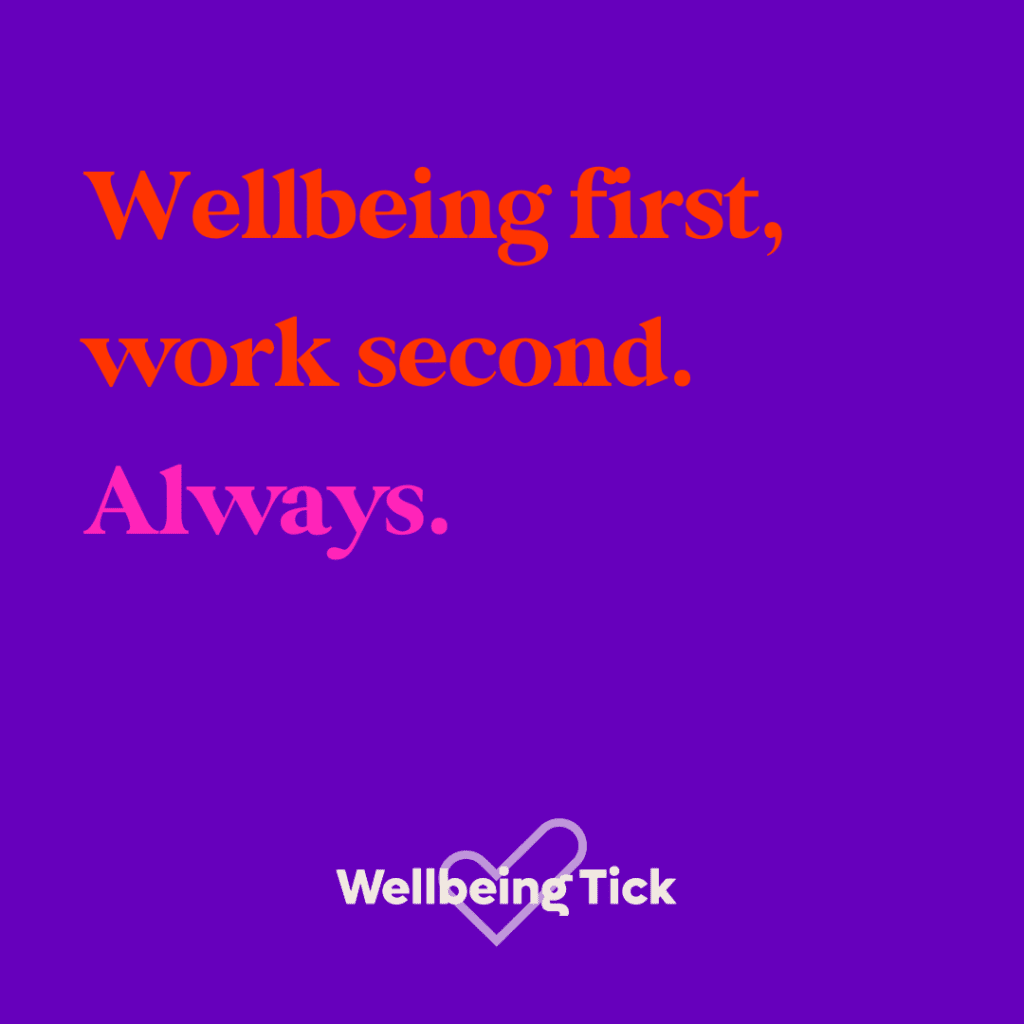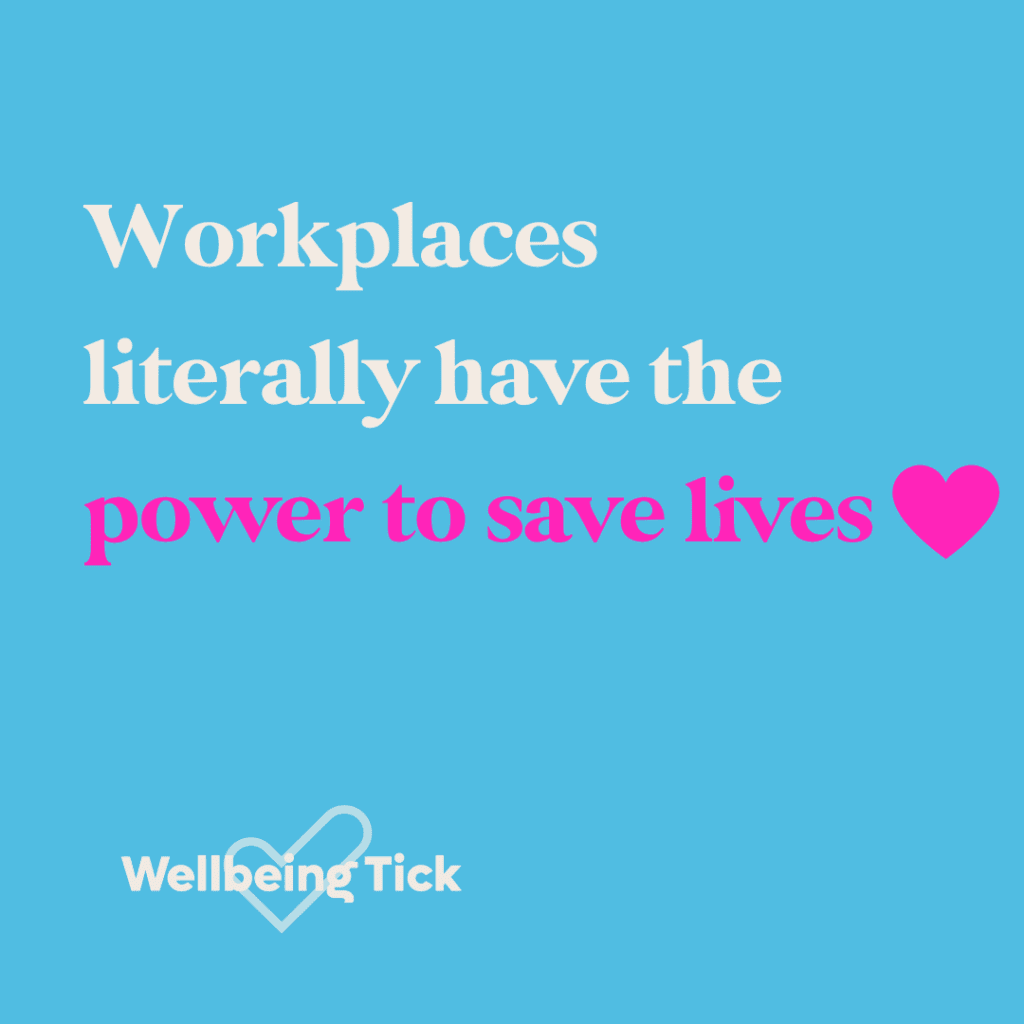After two years of a pandemic and working from home, smart companies are focusing more on workplace wellbeing. We talk to Philly Powell, creator of Wellbeing Tick, about why this work is so important.
On Philly Powell’s Instagram page, there’s a tile that acts as a bit of a litmus test for the kind of corporate environments you might have worked in.

It reads: “Wellbeing first, work second. Always.” And if you also had a somewhat physical reaction to reading that, you’ll probably be unsurprised to know that Philly herself only felt able to write that fairly recently.
“I only felt like I had the permission to state that once I’d left the corporate world,” she laughs. “Saying that kind of thing within a corporate environment… you just can’t. They’re often so focussed on performance, productivity, making money. Not about humans, or treating people well. Even though the human resource is actually the most important part of this business.”
After somewhat falling into an HR role after training in tourism management, Philly first entered the industry working in payroll in an HR team and fell in love with what HR stood for. “I had a really strong sense of people being treated fairly in the workplace,” she says. “I started seeing the impact that work was actually having on people’s wellbeing; that it wasn’t all sunshine and rainbows, there was some pretty shitty stuff happening in the workplace.”
Not only were there toxic behaviours happening in some of those workplaces, they also weren’t being addressed by those in charge and so Philly learned about good workplace wellbeing practices – as so many of us do – by being shown what not to do. So when a job came up to work at Chorus, to design and lead a wellbeing programme, it seemed like a great opportunity to lead from the front, rather than make changes to broken systems.
“The rise of stress, unmanageable workloads and the pressure that was being put on people, along with this always on, harden up, back-to-back meetings, work-at-our-fingertips mentality, was a dangerous combination,” Philly says. “I knew we needed a mental health strategy and that we needed the leadership team to be on board.”
In the past six years, Philly has focused entirely on what is workplace wellbeing and what does it look like when it’s done well, and that’s lead to the Wellbeing Tick, a workplace accreditation programme for companies that are committed to improving their culture. Based on Philly’s award-winning, globally researched and evidence based workplace wellbeing framework, Wellbeing Tick covers eight different wellbeing pillars that organisations are guided through. After a company wide survey and focus groups, Wellbeing Tick creates a report and recommendations on how they can improve, through workshops and regular check-ins.


As well as the “Wellbeing first, work second,” message, Philly also says one of her biggest messages is that “workplaces literally have the power to save lives.” Because when a workplace gets it right and supports the holistic health and wellbeing of its workers, the benefits are numerous. “It’s retention – you don’t have people leaving your business, and its reputation, because they’re not telling people that your workplace is a toxic place to work,” she says.
“It’s better for productivity; if your employees feel empowered and valued, there’s higher engagement. When you feel cared for and your manager has your back when the workload is high and you are feeling stressed, then it’s not like you’re taking on that sole responsibility. Stress levels decrease – you sleep better, you work smarter, you come back to work refreshed. We start to snowball in the right direction, rather than the wrong direction.”
And that wrong direction can have pretty dire consequences for people – as consistently poor working environments coupled with constant stress can lead to burnout. “It’s evident that we’ve got a burnout crisis on hand in New Zealand and we need to address it,” Philly says.
The pivot to remote working for many workplaces was so swift and so across the board, it has completely changed how we work…forever and for the better, Philly says. “Working at home went from being a privilege that was only available to certain roles in an organisation – and only the most progressive workplaces had good flexible working policies – and then Covid hit and it became a necessity. But at that time when it was a necessity, it was also a novelty.”
Two years later, that novelty has worn off and Philly says that the endless Zoom meetings replacing in-office brainstorms or quick chats has often made her “want to throw my computer out the window!”
“When I’m talking to employees and organisations now, there’s a massive issue of loneliness, isolation, and lack of social connection,” Philly says. “There’s no more fun, people are sick of working at home with kids, partners, flatmates. Some people still love working at home, some hate it and then there are a lot in the in-between, who want that balance. The workplace is about connection and collaborative working – those two minute, off-the-cuff conversations in the kitchen – and now to solve that two-minute kitchen question, you have to schedule a half hour video chat. And then before you know, your day if full of back-to-back meetings.”
But on the flip side, the pandemic and all those lounge zooms has meant that people now bring their full self to work now, which is a great thing. “Now with the pandemic, where we opened up our homes and we showed our pets, and our children and our partners and we were wearing our PJs on the bottom, we’ve become a lot more real and we’ve opened up the conversation around mental health. So there are positives as well.”
With a more permanent spotlight placed on employee mental health, Philly is already seeing an increased interest in programmes like Wellbeing Tick and she hopes that momentum will continue. “Companies need to be proactive about improving company culture, creating strategies around hybrid working and checking in with how they need to support their people, because the level of workplace burnout and pressure isn’t sustainable. It needs to be addressed immediately – and these are big, systemic issues that don’t get fixed overnight. And now in order to be attracting top talent, you have to be creating an enviable company culture.”
“I always remind people that workplaces actually have an obligation to provide a psychologically and physically healthy environment,” Philly says. “This is a time like no other in our history – with a pandemic, a war and so much burnout. Companies have to start paying attention.”

